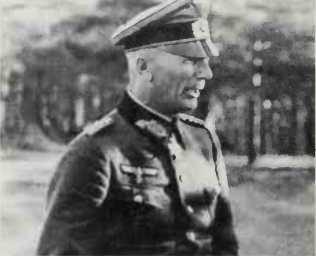Unfair: certainly, when ordered to take personal command of Allied land forces in New Guinea, in September 1942, Blarney competently directed the Kokoda Trail offensive that resulted in the recapture of Buna early in 1943. Thereafter, although he retained his appointment, the Australian troops under his command were mainly employed in comparatively minor operations in New Guinea and the Solomons. Retiring in 1946, Blarney was briefly recalled in 1950 in order to be promoted Field Marshal; the first Australian soldier thus distinguished. RO’N.
Blanchard, Gen Jean-Georges-Maurice (1877-1954). Fr. As c-in-c, French First Army, May 1940, Blanchard attempted to hold the Gembloux Gap on the Dyle Line against Hopner’s XVI Panzer Corps. Succeeding Billotte as Commander, 1st Army Group, May 25, Blanchard - although not fully cooperating with bef and Belgian commanders - oversaw First Army’s rearguard action in the retreat to Dunkirk.
Blaskowitz, Gen Johannes
(1883-1948). Ger. Blaskowitz commanded the German Eighth Army in Poland in 1939 and the First Army in France from October 1940 to May 1944. He then became commander of Army Group G, skilfully conducting the German withdrawal from southern France, but was replaced in September 1944. In January 1945 he took over Army Group H, his post being redesignated as c-in-c Netherlands that April. He committed suicide shortly before his trial for minor war crimes.
Blenheim, Bristol (Br, WWII). Medium bomber/long-range fighter; crew 3. First Blenheim I flew June 25 1936, quantity deliveries from early 1937; 18 squadrons by end 1938. Mark IV (long-nose) version in production 1939; built in Canada as Bolingbroke. Many fighter conversions. Unsuccessful Mk V (Bisley) intended to be close-support or high-altitude bomber. Production all Marks 6,355. Two 840/920/950 Bristol Mercury VIII/ XV/25 or 30 engines; max. speed 285mph (456kph); up to six 0.303in machine guns, 1,0001b (450kg) bombs.
Bleriot XI (French, early WWl). Single-seat/two-seat reconnaissance. Developed from Louis Bler-iot’s 1909 cross-Channel monoplane; existed in several sizes/ forms. Used in Italo-Turkish War 1911-12, Balkan Wars, early months World War 1; thereafter as trainer. 50hp or 80hp Gnome engine; max. speed 75mph (120kph); makeshift armament of pistols and/or rifle or carbine.
Bletchley Park. British deciphering centre (Government Code and Cipher School) in Buckinghamshire. With indispensable Polish and French help at the start, Bletchley broke most but not all of the German armed forces’ “Enigma” machine ciphers, starting with a Luftwaffe cipher in May 1940. By 1943 Hitler’s personal orders to his commanders and Donitz’s instructions to U-boats could often be read.
These were priceless insights into the enemy’s mind; extra care was taken to ensure he knew nothing of them. Everything from Bletchley was graded “Ultra” - top secret. Churchill himself controlled the short list of those who saw it. Bletchley staff, who came to number several thousand, were a mixture of academics, intellectuals, clerks, and post office engineers; these last developed the world’s first electronic computer. Alan Turing, Josh Cooper and Gordon Welchman were the leading brains. Everybody concerned kept the secret for nearly 30 years. MF.
Blitz. British slang for German air attack.
Blitzkrieg. “Lightning war”. German mechanized and air-supported operations in World War II, notably in Poland in 1939, France in 1940 and Russia in 1941.
Blomberg, Field Marshal Werner von (1878-1946). Ger. After service as a staff officer during World War I, von Blomberg’s career progressed steadily in the Reichswehr and on January 1 1933 he was appointed Germany’s Minister of Defence. A month later the Nazis came to power but von Blomberg, an admirer of Hitler, retained his post. He showed his loyalty in June 1934 by refraining from interfering in the internecine “Night of the Long Knives” and by subsequently supporting Hitler’s claim to absolute authority after the death of von Hindenburg. Furthermore, his order that the army swear an oath of personal allegiance to the Fiihrer greatly diminished the chances of an army opposition to the Nazis. In 1935, he was made c-in-c of the Wehrmacht and, a year later, promoted Field Marshal. However, von Blomberg was regarded with some suspicion and envy within the Nazi party, notably by Himmler and Goring who conspired together to end his career. In January 1938 the widowed von Blomberg judiciously married a young woman with a past that embraced prostitution and pornography. His enemies leaked details of these dubious activities and in the ensuing scandal engineered his resignation in February 1938. Hitler assumed the posts of Minister of Defence and Supreme Commander of the Armed Forces. MS.
Bloody April. British name for April 1917 when the rfc and rnas lost 151 aircraft and 316 aircrew killed or missing over the Western Front.
“Bloody Ridge” (“Edson’s Ridge”), Battle of (September 12—14 1942). Late on September 12, Maj Gen Kiyotake Kawaguchi’s 3,500-strong 35th Brigade attacked the defensive perimeter along the Lunga river, cl,000yd (914m) south of Henderson Field, Guadalcanal, held by c300 US Marines (Col Edson). In spite of gunfire support from Japanese destroyers in Ironbottom Sound, the attacks were repulsed. Determined infiltration attempts and frontal banzai charges were made on the night of September 13-14. With pre-planned artillery support, the Marines narrowly held their ground (143 killed and wounded). The Japanese withdrew, leaving 600 dead and suffering around 1,500 further losses in retreat. RO’N.
Truce talks and to test the kok army which had been rebuilt by Gen Van Fleet. The feature was tenaciously defended by the. nkpa and the kok assault was repelled. On August 27 American troops wei’e committed. After heavy fighting, the enemy evacuated the feature on September 5. In the fighting, which resembled the trench warfare of World War I, the NKPA suffered 15.000 casualties, the ROK over 1,000 and the Americans 3,000. CM. See also heartbreak RIDGE.
Blowpipe missile. A widely exported British-made man-held anti-aircraft missile that is guided onto its target by radio command signals. The missile requires a high level of skill from the operator but it can be very effective; in the Falklands in 1982, British Blowpipes accounted for a Macchi 339 and two Pucaras while an Argentine Blowpipe shot down a Harrier. The automatic command-to-line-of-sight successor system is Javelin, whose launcher can fire the older missile.
Blucher. German cruisers. (1) Armoured cruiser; built because of rumours of the British Invincibles, but, with only an armament of 8.2in guns and less speed, was much inferior. Sacrificed at the Dogger Bank Battle (1915). (2) Heavy cruiser; lost just after completion to shore batteries and torpedoes in Oslo Qord during the invasion of Norway (1940).
Bluff Cove. Settlement on southeast of East Falkland. During the Falklands War of 1982 it was selected, with Fitzroy Settlement, as 5th Brigade’s jumping-off base for the capture of Port Stanley, some 20 miles (32km) to the northeast. 2 Para were lifted to Fitzroy by helicopter on June 6 and the Scots and Welsh Guards were shipped around from San Carlos Water. On June 8, half of the Welsh Guards were still aboard the Landing Ship Logistic (lsl) Sir Galahad off Port Pleasant, the harbour for Fitzroy, when she was hit and set ablaze by bombs from Argentine fighter-bombers. The Welsh Guards sustained heavy casualties and lost most of their equipment in this attack, in which another e. sl, the Sir Tristram, was also hit. MH.
Blumentritt, Lt Gen {General der Infanterie) Gunther (1893-1967). Ger. A distinguished staff officer whose career was closely linked to those of Field Marshals von Rund-stedt and von Kluge. Blumentritt was Rundstedt’s senior operations officer in Poland (Army Group South), 1939, and in the French campaign (Army Group A), 1940, where he was concerned in planning for the invasion of Britain (claiming, postwar, that it was “never contemplated as a serious operation”). From November 1940 he was cos of Kluge’s Fourth Army, which formed part of Army Group Centre in the Smolensk-Moscow offensives, 1941-42. In September 1942, following service as head of the operations department of the General Staff, okh, he became cos to Rundstedt, c-in-c West, the energetic and genial Blumentritt ideally supplementing the elderly, somewhat disillusioned patrician. However, Blumentritt appears to have shared Rundstedt’s oversanguine attitude to the Allied invasion threat; while after the Normandy landings his task was made increasingly difficult by Hitler’s arbitrary and specific demands. Blumentritt survived Rundstedt’s dismissal in July 1944 to serve as cos to his successors Kluge (committed suicide, August 1944) and Model. Replaced by Westphal in September 1944, he was given a series of short-lived combat com-
• mands: 12th SS Division; Twenty-fifth Army; and, from March 27 1945, First Parachute Army in the retreat from the Rhine. Finally ordered to hold a Bremen-Hamburg line, he concentrated on orderly retreat rather than resistance, facilitating British capture of Hamburg and Liibeck. RO’N.
BMP. The Soviet infantry combat vehicle first developed in the 1960s to give infantry a mobile means of fighting on a nuclear battlefield. It entered service in the Soviet Army in 1967 and has since been widely exported as well as being produced in China and Czechoslovakia: The BMP-1 has a crew of three and carries an infantry section of eight men with firing ports for their weapons. It is armed with a 73mm gun and a Sagger anti-tank missile launcher and has 14mm protection. A new BMP-2 has been developed with capacity for only seven men but improved armament (30mm gun and Spandrel or Spigot missile launchers) and improved protection. EJG.

Field Marshal Fedor von Bock
Bock, Field Marshal Fedor von
(1880-1945). Ger. The son of a Prussian general, Bock spent the early part of World War I on General Staff duties, but commanded a Foot Guards battalion on the Western Front in 1917-18, winning Imperial Germany’s highest gallantry award, the Pour le Me-rite. Continuing to rise in his profession, he led the German forces which occupied Austria in 1938. Haughty, humourless and ambitious, Bock despised the Nazis but was prepared to support Hitler as long as the Army was strengthened and his own career flourished. He commanded Army Group North in Poland and, in 1940, commanded Army Group B in the west, overrunning the Low Countries and northwestern France. Promoted Field Marshal after the French campaign, he led Army Group Centre in the invasion of Russia in 1941. Normally an industrious rather than an inspired commander, Bock nevertheless encircled and destroyed several Soviet armies at Minsk, Smolensk and Gomel but was robbed of the chance of taking Moscow by Hitler’s untimely transfer of panzer units to the north and south in August. When the drive on Moscow resumed, it ground to a halt in the Russian winter and Bock, suffering from ulcers, was I’elieved of command on December 18. A month later he was given command of Army Group South, only to be removed in July 1942 following strategic disagreements with Hitler. He was killed in an Allied air attack. PJS.




 World History
World History









